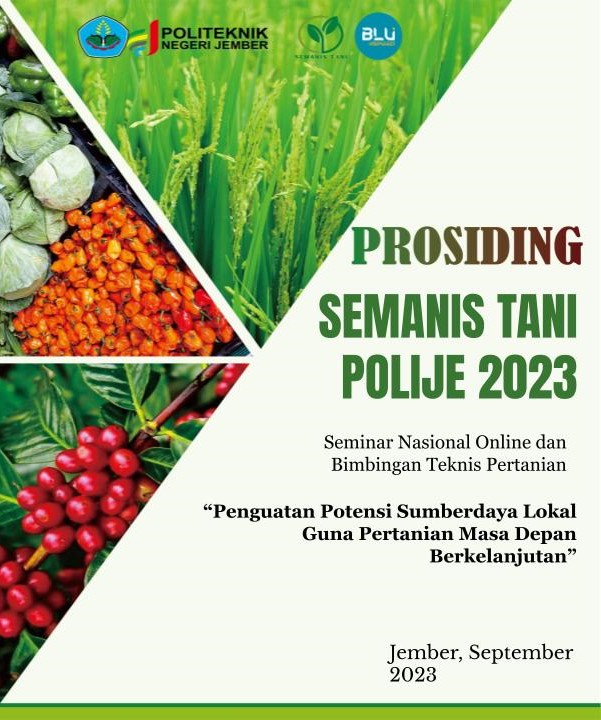Pengaruh Jarak Tanam dan Dosis Pupuk NPK Terhadap Produksi dan Mutu Benih Mentimun (Cucumis sativus L.)
DOI:
https://doi.org/10.25047/agropross.2023.493Kata Kunci:
cucumber, NPK, planting distance, seedAbstrak
Cucumber fruit is a fruit that has various benefits in everyday life, including food, medicine, and cosmetics. Cucumber cultivation is still not good enough so that it cannot meet domestic market demand. This study aims to determine the effect of the interaction between spacing treatment and doses of NPK fertilizer on the production and quality of cucumber seeds. This study used a factorial randomized complete block design (RCBD). The first factor was the treatment of spacing with 3 treatment levels and the second factor was the application of NPK fertilizer with 3 treatment levels. Each treatment was repeated 3 times, so there were 27 experimental units. The results of this study are based on the results of the analysis and discussion of the treatment spacing of 40 cm x 60 cm which has a very significant effect on the diameter of the fruit having an average of 7.18 cm, the length of the fruit having an average of 27.24 cm, and the weight of 100 grains having an average an average of 2.29 grams. NPK fertilizer dose treatment of 250 kg/Ha had a very significant effect on the fruit diameter had an average of 7.18 cm, fruit length had an average of
27.24 cm, flowering age had an average of 24.33 HST, number of seeds per fruit has an average of
315.47 grains, seed weight per fruit has an average of 7.37 grams, weight of 100 seeds has an average of 2.29 grams and seed weight per hectare has an average of 159.26 kilograms. The treatment interaction with a spacing of 40 cm x 60 cm and a dose of NPK fertilizer of 250 kg/ha gave the best value for fruit weight, namely 737.87 grams. Furthermore, the observation parameters that show significant or very significant differences are further tested using the DMRT test with a level of 5%.
Unduhan
Referensi
Haryadi, D., Yetti, H., & Yoseva, S. (2015). “Pengaruh Pemberian Beberapa Jenis Pupuk terhadap Pertumbuhan dan Produksi Tanaman Kailan (Brassica alboglabra L.)”. Dalam Jurnal Jom Faperta 2(2) : 99–102. Universitas Riau. Riau. https://jom.unri.ac.id [15 Juni 2022]
Kaya, E. 2013. “Pengaruh Kompos Jerami dan Pupuk NPK Terhadap N-Tersedia Tanah, Serapan N, Pertumbuhan, dan Hasil Padi Sawah (Oryza sativa L)”. Dalam Jurnal Ilmu Budidaya Tanaman. 2(1) : 43-50. Universitas Pattimura. Ambon. https://ojs.unpatti.ac.id/ [23 Mei 2022]
Lingga, P dan Marsono. 2009. Petunjuk Penggunaan Pupuk. Jakarta : Penebar Swadaya
Saddam H. 2019. “Interval Pemberian Air Kelapa dan Pupuk NPK 16:16:16 terhadap Pertumbuhan dan Produksi Mentimun Jepang (Cucumis sativus var. Japonese)”. Universitas Muhammadiyah Sumatera Utara. Medan. http://repository.umsu.ac.id/. [22 Juli 2022]
Sutedjo, M.M. (2008). Pupuk dan Cara Pemupukan. Jakarta: Rineka Cipta.
Suwarno, V. S. 2013. Respon Pertumbuhan dan Produksi Tanaman Mentimun (Cucumis sativus L.) Melalui Perlakuan Pupuk NPK Pelangi. Dalam Jurnal Karya Ilmiah Mahasiswa Universitas Negeri Gorontalo. 1(1): 1-12. https://repository.ung.ac.id/ [1 Februari 2023]
Tien, T., Widodo, W dan Kanta. 2012. “Karakterisasi Pertumbuhan dan Hasil Beberapa Varietas Padi Akibat Pengaturan Jarak Tanam yang Berbeda di Lahan Sawah Irigasi”. Dalam Jurnal Agribisnis dan Pengembangan Wilayah 3(2). Universitas Winaya Mukti. Bandung. https://jurnal.unismabekasi.ac.id [23 Juni 2022]
Unduhan
Diterbitkan
Cara Mengutip
Terbitan
Bagian
Lisensi
Hak Cipta (c) 2023 Muhammad Fuad Amsyari, Sri Rahayu

Artikel ini berlisensi Creative Commons Attribution 4.0 International License.
Hak cipta (Copyright) artikel yang dipublikasikan di Agropross : National Conference Proceedings of Agriculture dipegang oleh penulis (Copyright by Authors) di bawah Creative Commons Attribution 4.0 International License (CC-BY). Sehingga penulis tidak memerlukan perjanjian pengalihan hak cipta yang harus diserahkan kepada redaksi.






